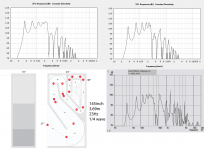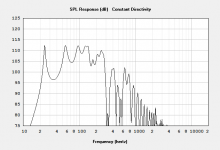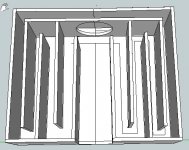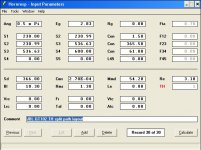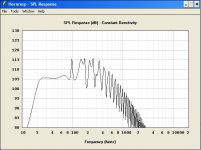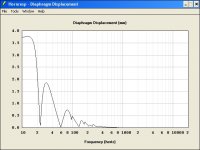Looks quiet interesting mate!
Did you ever try to model your special TH designs with any software or did you just assume that it will work propperly because of your experienced know-how?
edit:
Sorry, you ware even faster than I was able to think....
Did you ever try to model your special TH designs with any software or did you just assume that it will work propperly because of your experienced know-how?
edit:
Sorry, you ware even faster than I was able to think....
Last edited:
Well Lee I would be happy to model it in Hornresp if you want. I have designed a built quite a few horns over the years and have found Hornresp to be very accurate predictor of the results of a driver/horn system.
Mark
Mark
Why did you choose such a high Qts driver?
Just because I have four of these drivers already installed, and have four more needing a good home. 😀 These are mid-eighties drivers BTW. As far as "experience", these are the first horns I build, but have read a lot from others' experience and have built a few transmission lines. I wished I could have made the enclosure 1/2 wave instead of 1/4 wave, but there's a space contingency in my basement for four bins... 😉
Last edited:
I have updated the diagram on post ##3538 to display the progression of the horn. The diagram shoes that the progression is virtually a quarter of a circle that has been expanded horizontally.
Unfortunately, I'm with Blamus. I've struggled to be able to design my own TH, but have come up with lots of HR designs. Translating to a compact box is very difficult. I want to do more, but there are lots of us lurking about who would like to find more completed plans out there to copy. The 25hz anarchy is a good example, but at $80/driver, I'd rather use my old 8" JL Audio car sub's which actually model very well in the same plan-but how to enlarge for the bigger driver? You would be a hero if you could help with that.
Attached you have the sims of Lee's design.
On the left side you have the sim in 0.5xPi and on the right the same in 2.0xPi, both modeled in HR as a TH.
On the bottom right for comparison a 2.0xPi sim made with Akabak.
...seems that the design needs to get a little bit fine tuned.
btw, someone else once tried something similar:
Basshorn212 - Speakerplans.com Forums - Page 1
gzg
On the left side you have the sim in 0.5xPi and on the right the same in 2.0xPi, both modeled in HR as a TH.
On the bottom right for comparison a 2.0xPi sim made with Akabak.
...seems that the design needs to get a little bit fine tuned.
btw, someone else once tried something similar:
Basshorn212 - Speakerplans.com Forums - Page 1
gzg
Attachments
Thanks Ibex for the modeling. So, I got volume and I got the length. What's causing all the ripples?
This afternoon I spent some time making the horn longer and simpler. I am 200ft now. ;-)
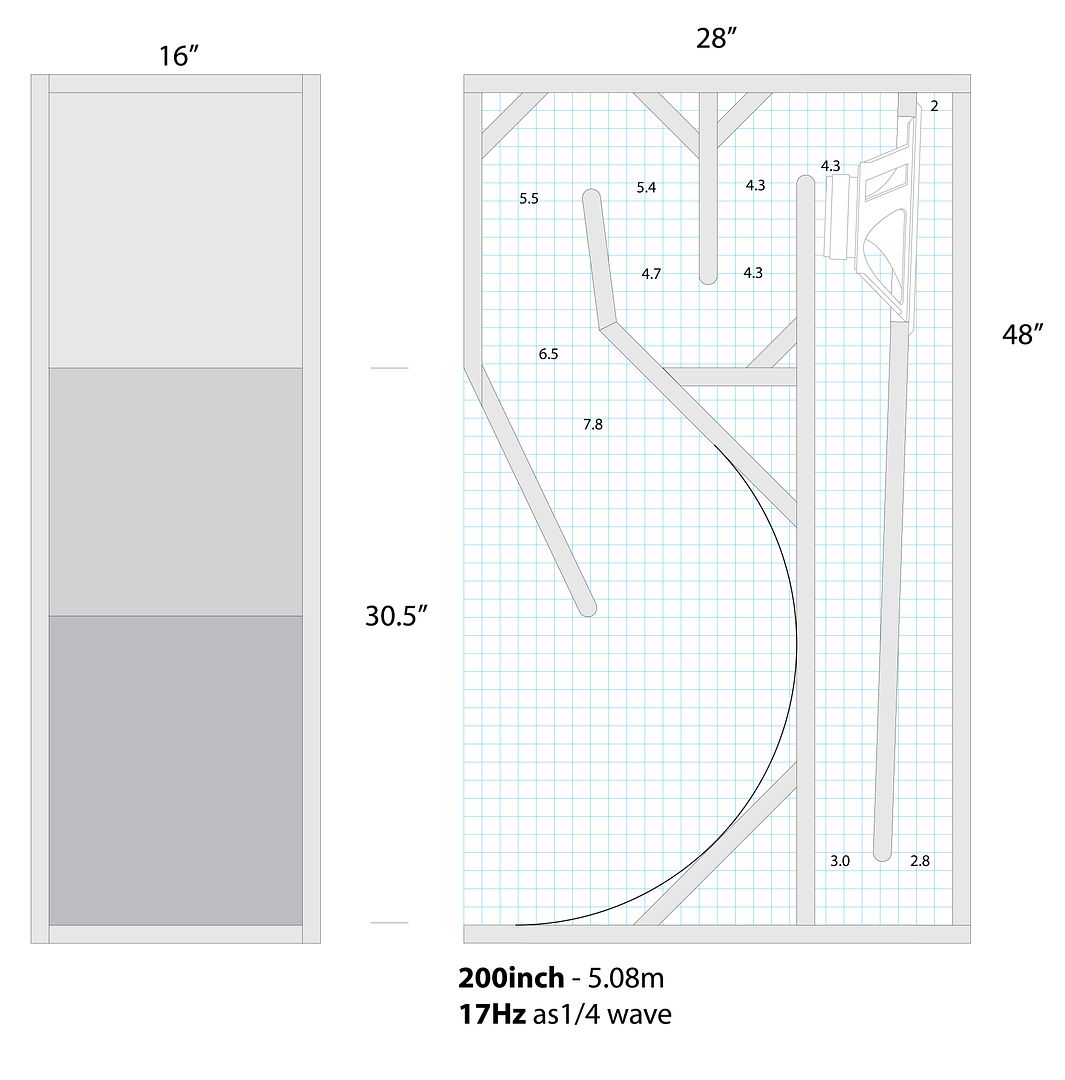
This afternoon I spent some time making the horn longer and simpler. I am 200ft now. ;-)

Well I haven't looked if you have already but if not post the specs of your driver I could come up with something in pretty short order. Other wise the MCM 55-2421 8" Woofer out does anything I've seen for fantastic performance in a small tapped horn and it cost only $35. I built one for my car and it beat the pants off the Dayton reference series 10" Sub I had in a 1cf ported box!
Brsanko- even if you just shared your plans, I'd be forever grateful or if you could help me remodel the anarchy 25hz model for an 8", that would be great. I need to x/o at 100hz and go down to 30hz if possible However, my old Jl W1 drivers from the anarchy 25hz model are as follows:Ang=1.0 x Pi
Eg=2.83
Rg=0.00
Fta=0.55
S1=57.00
S2=61.00
Con=9.00
F12=0.00
S2=61.00
S3=219.00
Con=328.00
F23=0.00
S3=219.00
S4=250.00
Con=60.00
F34=0.00
S4=0.00
S5=0.00
L45=0.00
F45=0.00
Sd=198.06
Bl=9.95
Cms=4.56E-04
Rms=0.91
Mmd=48.79
Le=1.00
Re=3.34
TH=1
Eg=2.83
Rg=0.00
Fta=0.55
S1=57.00
S2=61.00
Con=9.00
F12=0.00
S2=61.00
S3=219.00
Con=328.00
F23=0.00
S3=219.00
S4=250.00
Con=60.00
F34=0.00
S4=0.00
S5=0.00
L45=0.00
F45=0.00
Sd=198.06
Bl=9.95
Cms=4.56E-04
Rms=0.91
Mmd=48.79
Le=1.00
Re=3.34
TH=1
Good model Ibex!
I just got home.
THe ribble can be from two sources mismatch on the horn throat and the mouth. Without having done my own model yet I cannot tell you exactly.
If Ibex posts the input screen it could spped things up. I'm working late tomorrow to.
Life in the fast lane!
But you do have a great idea for a horn fold and its construction. So don't give up to easily.
Mark
I just got home.
THe ribble can be from two sources mismatch on the horn throat and the mouth. Without having done my own model yet I cannot tell you exactly.
If Ibex posts the input screen it could spped things up. I'm working late tomorrow to.
Life in the fast lane!
But you do have a great idea for a horn fold and its construction. So don't give up to easily.
Mark
"Thanks Ibex for the modeling. So, I got volume and I got the length. What's causing all the ripples?"
Mainly it's the bad placement of the tap. It usually wants to reside at the end of the horn. It can be further in if driver parameters and horn geometry allows it.
The drivers parameters doesn't help ether as it's not that good.
Way to weak with way to high Qts and low Fs.
It starts to behave decent in a 5m 700L box. But 105dB at 20Hz is not impressive for such a big cab.
You really need to start modeling in hornresp. There is no excuse not to.
Doing what you are doing now is just a waste of time and energy unless you really like doing it, over and over.
You will probably never be happy with that driver in a TH that looks remotely like that.
Sorry but any sim with that driver and the tap at any other position than mouth is worse yielding extreme peaks and dips.
But that's just my opinion.
Mainly it's the bad placement of the tap. It usually wants to reside at the end of the horn. It can be further in if driver parameters and horn geometry allows it.
The drivers parameters doesn't help ether as it's not that good.
Way to weak with way to high Qts and low Fs.
It starts to behave decent in a 5m 700L box. But 105dB at 20Hz is not impressive for such a big cab.
You really need to start modeling in hornresp. There is no excuse not to.
Doing what you are doing now is just a waste of time and energy unless you really like doing it, over and over.
You will probably never be happy with that driver in a TH that looks remotely like that.
Sorry but any sim with that driver and the tap at any other position than mouth is worse yielding extreme peaks and dips.
But that's just my opinion.
Hi lee,
I tried to model your last 200inch TH design with HR, unfortunately the cancelations still occur, though the design offers an deeper cut-off due to the increased horn path length.
note:
In the sim I modeled the horn segment from the mouth down to the rear of the driver just as an simple expo flare to make it easier, but that doesn't make any difference referring to the cancelations.
gzg
I tried to model your last 200inch TH design with HR, unfortunately the cancelations still occur, though the design offers an deeper cut-off due to the increased horn path length.
note:
In the sim I modeled the horn segment from the mouth down to the rear of the driver just as an simple expo flare to make it easier, but that doesn't make any difference referring to the cancelations.
gzg
Attachments
Damn. I do reach 25Hz but everything around is weak. Okay then. I am very hard headed and I have to find a solution. Let's make it simple. It seems I have read that the following design should be strong with very low frequencies as the direct wave (from diaphragm) and the "tuned" wave (from labyrinth), should add on. What do you think, guys?
Also, I once read a comment that Kef drivers are not suitable with horns as the drivers are "mass loaded". Can anyone explain? Anyway, thanks for your patience. I appreciate sharing fails and successes ;-)
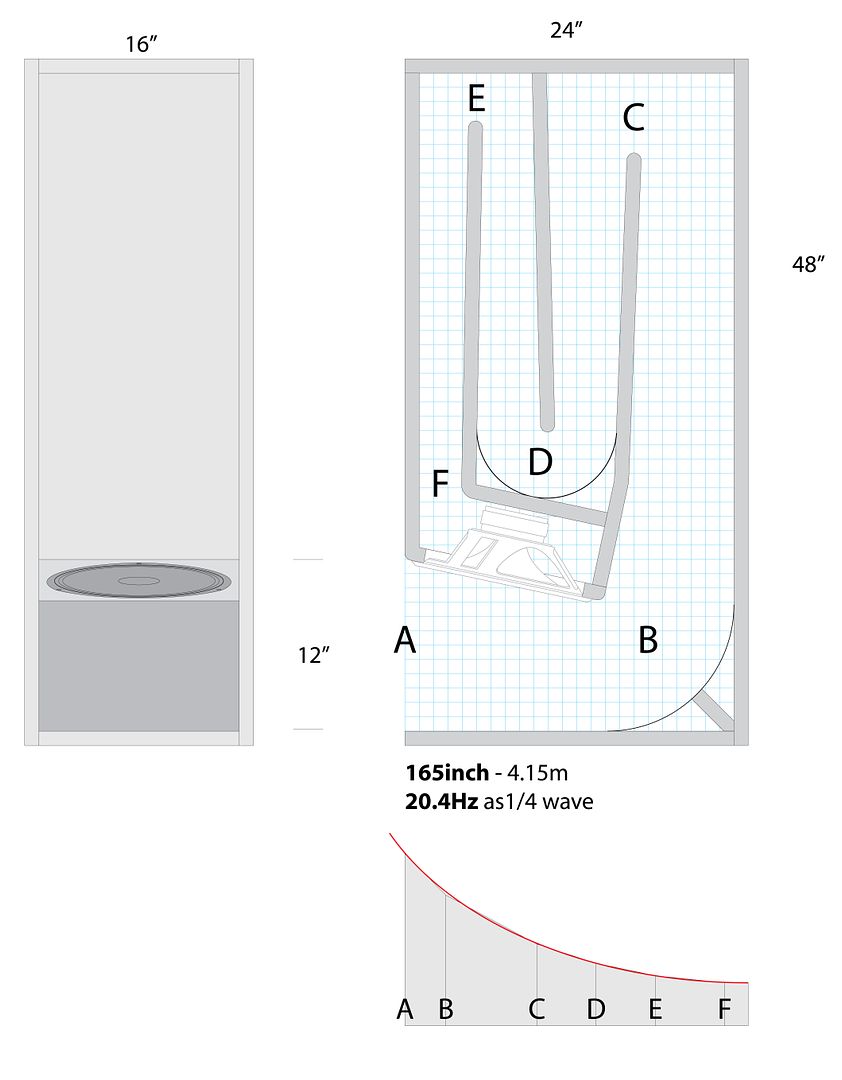
Also, I once read a comment that Kef drivers are not suitable with horns as the drivers are "mass loaded". Can anyone explain? Anyway, thanks for your patience. I appreciate sharing fails and successes ;-)

Hmm.. Thanks all. If the B300s are not appropriate for horns, then I might just shelf them for other purposes, and look for other drivers. I have my eyes on a pair of 15" JBL 2205h - 8 ohms - Qt 0.28 - Fs 30Hz
If they are strong enough for PA duty, they might be enough for home subs.
If they are strong enough for PA duty, they might be enough for home subs.
I do reach 25Hz but everything around is weak.
Also, I once read a comment that Kef drivers are not suitable with horns as the drivers are "mass loaded". Can anyone explain?
Right, it takes either a lot of driver Sd and/or Xmax to go low with authority, so with this driver combined with its relatively high Qes and Vas it takes 700+ L at rated power to make any semi-serious bass from Fs-up in a TH.
Well, it's laid out much better, though with a 23 Hz Fs (if it is), it needs at minimum a 23*0.8 = 18.4 Hz 1/4 WL path-length and a 11.5 Hz path-length to load it all the way to Fs. With some of today's ultra high power, Xmax drivers, its performance is easily bested in cabs half this size.
As presented this is completely misleading. To go low with any authority requires a 'massive' driver system. I assume that what you read was based on (mid) bass/woofer horn specs required back in the days of low power, high output impedance systems that required as much efficiency as they could design in.
These required low Qts, Fs and high Vas drivers, so that when coupled to the amp its effective Qts would be up around 0.4-0.5, right where the B300's is, so think of it not as massive per se, just its specs have been adjusted to work in the same design horn except driven with a very low output impedance, ergo will work fine in any other properly designed horn.
What it won't do is have the extended HF BW that a low Qts driver coupled to a very low output impedance does, so from this POV the B300 does seem 'too massive' for a horn app, but as always you need to choose the right driver for the intended app. In this driver's case, it's best suited for woofer duty since its HF mass corner is ~2*23/0.46 = 100 Hz.
GM
Hmm.. Thanks all. If the B300s are not appropriate for horns, then I might just shelf them for other purposes, and look for other drivers. I have my eyes on a pair of 15" JBL 2235h - 8 ohms - Qt 0.25 - Fs 20Hz
the wife dragged me to the garage sales today, but I was the only one who parted with any cash. I bought a JBL GT 102 10" sub driver. It's really an autosound driver, but I came home and googled the specs, and sat down and designed a Tapped Horn for it. If I can make the attachments load I'll show the Sketchup layout I did, and the Hornresp screens that are germane to my questions.
I sacrificed some overall gain to get as smooth a response as I could over the 2 octaves I intend to use it. There is an excursion issue below the pass band I wish to use it in. One of my questions to you experienced folks is, if I put together a passive line level highpass filter to go between the pre-amp and the plate amp, at 12Db/Octave where would I need to set the filter to keep the excursion below 20 Hz from launching the cone ( see attached displacement screen, if it attaches...)
All that I have read indicates that the actual results from Hornresp designs tend to be slightly smoother than indicated on the sim., and the bandwidth goes a little lower than indicated on the SPL graph.
Does this look like a viable design?
Commentary is welcome.
John
I sacrificed some overall gain to get as smooth a response as I could over the 2 octaves I intend to use it. There is an excursion issue below the pass band I wish to use it in. One of my questions to you experienced folks is, if I put together a passive line level highpass filter to go between the pre-amp and the plate amp, at 12Db/Octave where would I need to set the filter to keep the excursion below 20 Hz from launching the cone ( see attached displacement screen, if it attaches...)
All that I have read indicates that the actual results from Hornresp designs tend to be slightly smoother than indicated on the sim., and the bandwidth goes a little lower than indicated on the SPL graph.
Does this look like a viable design?
Commentary is welcome.
John
Attachments
- Home
- Loudspeakers
- Subwoofers
- Collaborative Tapped horn project
